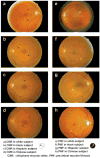Prevalence and risk factors for epiretinal membranes in a multi-ethnic United States population
- PMID: 21035863
- PMCID: PMC3070851
- DOI: 10.1016/j.ophtha.2010.08.009
Prevalence and risk factors for epiretinal membranes in a multi-ethnic United States population
Abstract
Purpose: To describe the prevalence of and risk factors for epiretinal membrane (ERM) in a multi-ethnic population and to evaluate possible racial or ethnic differences.
Design: Cross-sectional study.
Participants: Participants of the Multi-Ethnic Study of Atherosclerosis (MESA), examined at the second visit of the MESA when retinal photography was performed.
Methods: Data on 5960 participants aged 45 to 84 years from MESA, including white, black, Hispanic, and Chinese persons from 6 United States communities, were analyzed. Epiretinal membrane was assessed from digital nonstereoscopic fundus photographs and was defined as cellophane macular reflex (CMR) without retinal folds or preretinal macular fibrosis (PMF) with retinal folds. Risk factors were assessed from standardized interviews, clinical examinations, and laboratory investigations.
Main outcome measures: Epiretinal membrane prevalence by ethnic or racial group and risk factors associated with ERM.
Results: The prevalence of any ERM was 28.9%, of which 25.1% were CMR cases and 3.8% were PMF cases. The prevalence of ERM was significantly higher in Chinese persons (39.0%), compared with Hispanic (29.3%), white (27.5%), or black (26.2%; P<0.001) persons. In multivariate models, increasing age (odds ratio [OR], 1.19; 95% confidence interval [CI], 1.06-1.34, per year increase in age), diabetes (OR, 1.92; 95% CI, 1.39-2.65), and hypercholesterolemia (OR, 1.33; 95% CI, 1.04-1.69) were significantly associated with CMR.
Conclusions: This study showed that ERM was significantly more common in Chinese persons compared with whites, blacks, and Hispanics. Risk factors for ERM were increasing age, presence of diabetes, and hypercholesterolemia.
Copyright © 2011 American Academy of Ophthalmology. Published by Elsevier Inc. All rights reserved.
Conflict of interest statement
References
-
- Mitchell P, Smith W, Chey T, et al. Prevalence and associations of epiretinal membranes: the Blue Mountains Eye Study, Australia. Ophthalmology. 1997;104:1033–40. - PubMed
-
- Fraser-Bell S, Guzowski M, Rochtchina E, et al. Five-year cumulative incidence and progression of epiretinal membranes: the Blue Mountains Eye Study. Ophthalmology. 2003;110:34–40. - PubMed
-
- Fraser-Bell S, Ying-Lai M, Klein R, Varma R Los Angeles Latino Eye Study Group. Prevalence and associations of epiretinal membranes in Latinos: the Los Angeles Latino Eye Study. Invest Ophthalmol Vis Sci. 2004;45:1732–6. - PubMed
-
- McCarty DJ, Mukesh BN, Chikani V, et al. Prevalence and associations of epiretinal membranes in the Visual Impairment Project. Am J Ophthalmol. 2005;140:288–94. - PubMed
Publication types
MeSH terms
Grants and funding
- ZIA EY000403/ImNIH/Intramural NIH HHS/United States
- Z01EY000403/EY/NEI NIH HHS/United States
- Z01 EY000403/ImNIH/Intramural NIH HHS/United States
- N01-HC-95159/HC/NHLBI NIH HHS/United States
- N01-HC-95165/HC/NHLBI NIH HHS/United States
- N01 HC095159/HL/NHLBI NIH HHS/United States
- R01 HL069979/HL/NHLBI NIH HHS/United States
- N01-HC-95169/HC/NHLBI NIH HHS/United States
- HL69979-03/HL/NHLBI NIH HHS/United States
- N01 HC095165/HL/NHLBI NIH HHS/United States
- N01 HC095169/HL/NHLBI NIH HHS/United States
- Z99 EY999999/ImNIH/Intramural NIH HHS/United States
LinkOut - more resources
Full Text Sources
Medical
Molecular Biology Databases


